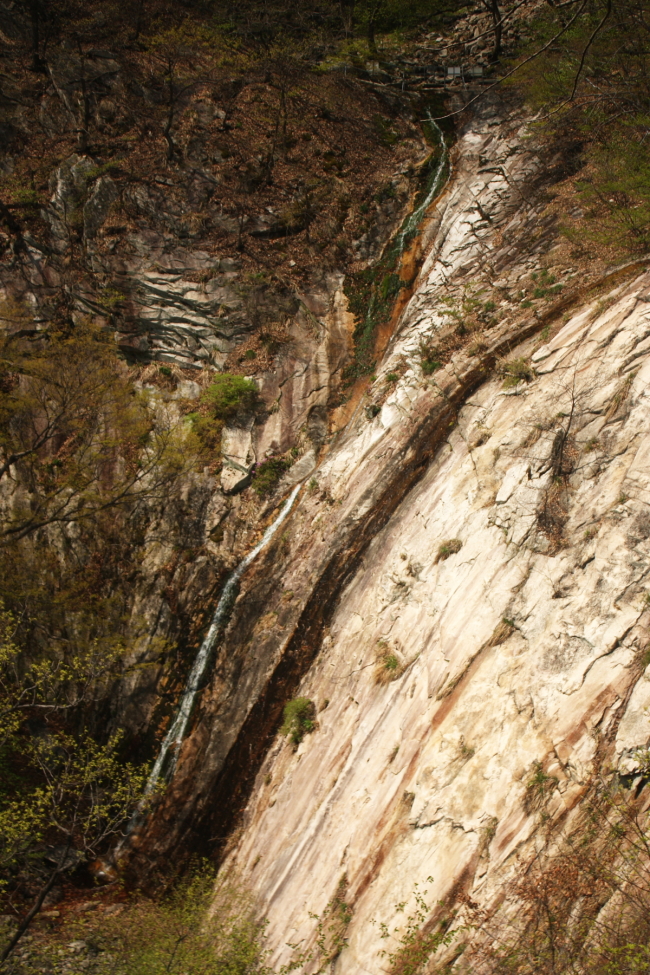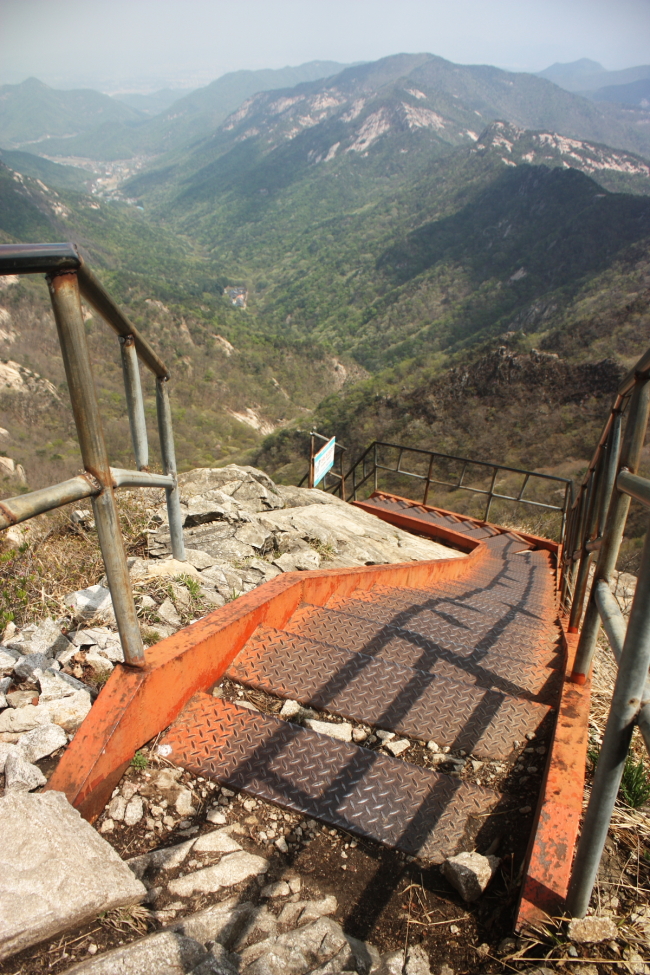From west Daejeon, Mount Gyeryongsan can be seen through the ring of mountains that encloses the plain. It appears rounded and slump-backed, but with a ripple on top like a rooster’s comb.
Daejeon, a base for science and technology research and development, had a brief spell of fame in 1993 as host of the World Expo. Since then, it has sunk back into a calm, provincial slumber. While the leftover monuments of the Expo have come to look dated, the national park on the outskirts has aged remarkably well.
By mid-April, spring had fully arrived at the bottom of Mount Gyeryongsan, though at the top many trees hadn’t yet unfolded their leaves. Meanwhile, pink lanterns graced the road in a reminder that Buddha’s Birthday was approaching.
From Donghaksa Temple, the first school for Korean Buddhist nuns, a well-tread path leads along a stream valley. Such valleys, called gyegok, normally draw families and couples on weekends, but this one is off-limits because of a salamander.
 |
The view of Eunseon Waterfall from a sightseeing platform at Gyeryongsan National Park (Matt Crawford/The Korea Herald) |
The Korean crevice salamander was only discovered in 2005 by a teacher from Illinois working at a Christian school in Daejeon. Previously, such lungless amphibians had not been known to exist in Asia.
Donghaksa Valley ends at Eunseonpokpo Waterfall (Hidden Immortals Waterfall), which pours down a granite cliff along a green chute of plants and mosses. For its white mist it is counted one of the Eight Views of the mountain, not to be confused with the Five Most Spectacular Natural Attractions, the Four Most Magnificent Sites or the Two Premier Attractions.
Looking up from here, one has a view of corroded cliffs and the gleam of a railing. At the top of the waterfall several benches make for a fine picnic spot.
A bouldery streambed, dry at this time of year, leads up to Gwaneumbong Peak at 816 meters in height, with a network of boardwalks and a concrete pavilion. Though the high points of Ssalgaebong Peak (828 m) and Cheonwangbong Peak (845 m) are within striking distance, both are off-limits to hikers.
 |
From the top of a set of stairs near Gwaneumbong Peak, the view extends from Donghaksa Valley to Daejeon in the far distance. (Matt Crawford/The Korea Herald) |
A popular and not-too-demanding route from Gwaneumbong Peak passes down and up the stone towers and along the thin ridgeline to Nammaetap Pagoda. The route is only possible for the average hiker thanks to the sets of stairs that have been drilled into the granite.
Despite the melodramatic music and spoken-word sermons playing from the speakers, the pagoda clearing is an ideal rest spot. In the olden days, a priest was said to have saved the life of a tiger here by dislodging a bone stuck in its throat. To repay the favor, the tiger brought a young woman to the cave. The two lived together as brother and sister, studied the scripture and reached enlightenment on the same day. A similar myth is associated with Donghaksa Temple down below.
Though matchmaking tigers have become extinct in the South, the park is said to be home to Korean badgers and raccoon dogs, and its icon is the ruddy kingfisher. The red-beaked, red-footed bird is most likely to be spotted in the summer.
Those with energy to spare can continue on to Janggunbong (General) Peak, which is actually a series of formidable “generals.” Some favor this remote end of the park as a starting point since there is no entrance charge.
On the Gongju side of the mountain are Gapsa Temple and Sinwonsa Temple, two other potential starting or ending points.
Near Sinwonsa is the Jungak Ancestral Shrine, the last of its kind in Korea. During the Joseon era, sacrificial rites to mountain gods were performed at Mount Myohyangsan in the north, Mount Jirisan in the south and Mount Gyeryongsan in the middle.
The ceremonies at this last remaining shrine were resumed in 1998 and have been held every April through the Gyeryongsan Mountain God Festival, with Confucian, Buddhist and shamanistic participation. Though invited to join, Christian groups have lobbied against the festival.
The mountain’s shamanistic credentials go deeper still. A several-hundred-year-old prophecy said that the Sindoan Valley, on the southern side of the park, would become the site of the capital of the dynasty that followed the Joseon era. A highly propitious space for shamanists, Sindoan was covered with shrines and temples until around 1983, when the Republic of Korea Army moved in.
With the construction of the Gyeryongdae complex, headquarters of the Army, Navy and Air Force, the valley became a restricted zone. The mountain god population remains threatened and sightings are rare.
Getting there:
Bus No. 107 travels from Daejeon Station to Donghaksa Temple, stopping at the Yuseong Intercity Bus Terminal and at Exit No. 3 of Hyeonchungwon Station. To reach Gapsa Temple from Yuseong District Office, take bus No. 104 and transfer to No. 342. From the city of Gongju, take bus No. 100 from Gongju High School and switch to No. 320 after five stops. For Shinwonsa Temple, transfer at the same stop to No. 310.
By Matthew C. Crawford (
mattcrawford@heraldcorp.com)









